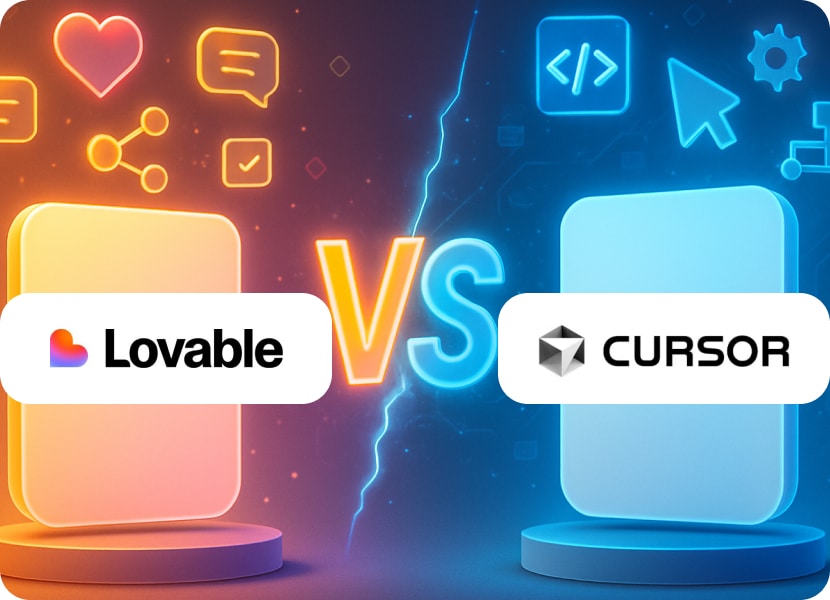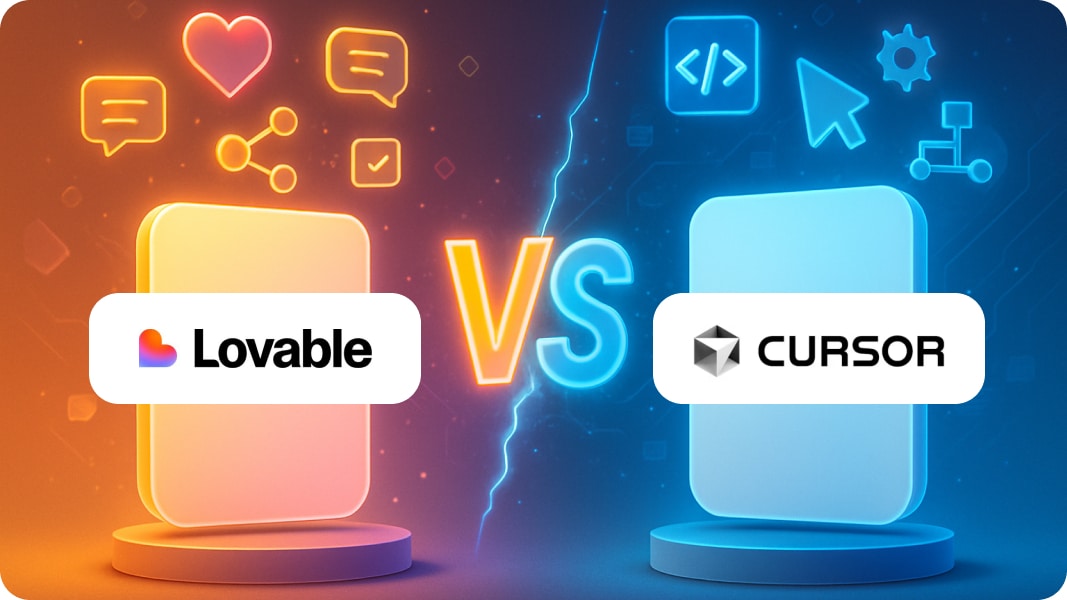

Lovable vs. Cursor: Which Vibe Coding Tool Works For You?
The revolution in vibe coding has arrived, and two platforms are definitely worth having a look at. Comparing Lovable vs. Cursor isn’t really fair, due to the fact that it’s like comparing a speedboat and a submarine. So, ok, even though they both offer vibe coding abilities, they’re going about vibe coding in what appears to be entirely different ways, but both get you to your destination in the end.
With close to 8 million users already, Lovable is becoming more and more popular as a platform for non-programmers who wish to quickly create full-stack applications, especially when they’re inundating your socials with those annoying little clips, but can it actually do what they claim? is the question we’re here to answer.
Cursor, on the other hand, is an AI-first IDE that enhances current coding workflows, dominated the developer market, and became the fastest tool to reach $100M ARR in just 12 months, so they’re not some small fry in any sense of the word.
Which one is best for you, then? Let’s have an honest discussion about what they’re able to do and who they best serve in order to dissect the Lovable vs. Cursor debate.
What Lovable Actually Does
Lovable converts written prompts into actual, production-quality code using ML and NLP, basically what every vibe coding service does. When you state simply, “Build a task control app with logins and collaboration capabilities,” Lovable goes ahead and constructs the application for you from front to back.
Lovable offers a truly accessible vibe coding experience. Lovable concentrates on real code generation, giving developers functional frontends, backends, and database logic in a matter of minutes, in contrast to drag-and-drop no-code tools. You’re saying or typing what you want and seeing a complete application come to life, not assembling UI elements.
Lovable’s Strengths
Speed to Working App:
It lets you turn ideas into apps just by describing them, speeding up the whole creation process. Lovable is excellent at quickly turning your concepts into deployable applications.
Full-Stack Generation:
Lovable supports the development of websites, full-stack applications, or internal tools by converting user-described concepts into working software. You’re getting functional apps, not just user interfaces.
Integrated Workflow:
Lovable allows for smooth development by natively integrating with platforms such as GitHub when you’re needing overall control and Supabase for all the backend stuff. The platform has all the features you require.
Ownership:
You get to keep the code Lovable creates, so you can tweak it and host it wherever you want, giving you full control over everything you’ve created.
Lovable is being used to “supercharge creativity” by over half of Fortune 500 companies, and the platform’s growth has been phenomenal. After growing to 30,000 paying clients, Lovable has generated $17 million in recurring revenue each year so far, which is a solid demonstration of the significant demand for vibe coding that caters to non-developers.
Limitations of Lovable:
Certain project types are best suited for the platform. What has been cited is that complex apps might still need a developer to make sure things scale smoothly and the code is top-notch, so that means you’ll need a dev on hand to ensure all goes according to plan when growing.
Lovable works incredibly well for MVPs, prototypes, and simple business applications, but it struggles when you’re dealing with very complex architectural requirements.
What Cursor Actually Does
Built from the ground up, Cursor is an AI-native code editor that seamlessly incorporates LLMs into your processes. Unlike Lovable’s “describe and generate” approach, Cursor enhances how developers actually code thanks to intelligent autocomplete, codebase-aware assistance, and AI-powered refactoring within a familiar IDE environment.
Built on top of Visual Studio Code, Cursor enhances familiar workflows with the intelligence of models like GPT-4, Claude, and its own optimized models. If you’re already a developer, Cursor feels like VS got superpowers.
Cursor’s Strengths:
Developer-first experience:
Context-aware AI indexes your project and makes recommendations according to your architecture by actually comprehending the codebase, not just the current file. What sets Cursor apart from other autocomplete tools is its fantastic contextual understanding.
Intelligent Code Completion:
The Cursor code editor predicts what you want based on the context of your code and provides you with intuitive full-line and multi-line code completions. The AI predicts your next move thanks to this subtle yet effective vibe coding.
Multiple Interaction Modes:
Cursor has features like Agent mode, which assigns coding tasks to you so you can concentrate on higher-level direction, and Composer, which allows you to make targeted edits or run terminal commands using natural language. How much AI help you want is up to you.
Familiar Setting:
Cursor supports a large number of the same Visual Studio Code extensions that you are already familiar with, such as debuggers, linters, language tools, and themes. If you’re coming from Visual Studio Code, there is almost no learning curve.
Model Flexibility:
OpenAI, Anthropic, Gemini, and xAI frontier models are all freely available for selection. Models can be switched according to their respective strengths.
Cursor has established itself as the enterprise standard for AI-enhanced development, with more than half of the Fortune 500 trusting it to accelerate development safely and at scale.
Cursor’s Limitations:
Cursor believes you are a developer already. If you know the fundamentals of software engineering, debugging, and code architecture, the coding experience is amazing. You will find it difficult to utilize the tool effectively if you don’t. Instead of teaching you how to develop from scratch, it speeds up the process.
The Lovable vs. Cursor Decision Matrix
Choose Lovable when:
- You are an entrepreneur, product executive, or non-technical founder with app concepts.
- Concepts must be rapidly validated without the need to hire developers.
- Your project (company apps, dashboards, prototypes) is fairly basic.
- Vibe coding that manages the entire structure automatically is what you want.
- More important than architectural control is the speed at which an idea is developed and implemented.
- You can’t afford a development team because of your tight budget.
Choose Cursor when:
- As an experienced developer, you wish to write code more quickly and intelligently.
- You’re working on intricate, expansive applications that call for architectural choices.
- Thorough control over implementation specifics and code quality is required.
- The process you use for vibe coding should complement current knowledge rather than replace it.
- You’re keeping up with outdated codebases that require clever reworking.
- The skilled engineers on your team want AI support, not AI replacement.
The Hybrid Reality
The fact that many teams use both, albeit at different stages, is something that is rarely discussed in the Lovable vs. Cursor debate.
Because Lovable provides functional applications in a matter of hours, product teams utilize it for stakeholder demos and rapid prototyping in order to test ideas and get feedback. Development teams utilize Cursor to construct the production version with appropriate architecture, scalability considerations, and technical proficiency after the concept has been verified and requirements have been established.
This hybrid vibe coding technique makes use of Cursor’s execution power and Lovable’s speed for exploration. It’s both, strategically applied, not either/or.
Where Noca Fits in the Vibe Coding Landscape
Noca explores vibe coding from a completely different perspective: enterprise management and integration of systems for non-devs.
Noca is excellent at creating business apps that require close integration with current enterprise systems. Noca’s vibe coding manages the orchestration layer automatically, whereas Lovable might have trouble with intricate integrations, and Cursor requires developers to manually wire everything together.
Consider it this way: Lovable quickly provides you with an app. Cursor facilitates the efficient creation of complex applications by developers. Noca creates complete, fully operational, and deployable apps that integrate with your current business systems to automate intricate processes. Different problems require different tools.
The Bottom Line on Lovable vs. Cursor
Two outstanding vibe coding platforms are revealed by comparing Lovable vs. Cursor.
Lovable makes software development readily available through allowing anyone, even without coding experience, to transform ideas into functional applications. Millions of people who were previously unable to participate in full-stack development can now do so thanks to Lovable’s flagship feature, vibe coding, which is a turning point in code-free development.
Cursor transforms the way professional developers work, increasing their output while preserving the sophistication and control required for complex software. When used properly, Cursor makes expert developers much more productive by feeling like an extension of their coding instincts.
In the vibe coding marketplace, neither platform is “better,” simply because they’re designed for entirely different uses. Choosing who to use should be based on your goals and brand, not on which platform has more impressive user counts or better marketing.
One tool won’t win the vibe coding revolution. It all comes down to having the most appropriate tool for every task, ability level, and developmental stage. Cursor and Lovable are both advancing that revolution, albeit in different ways.
FAQ
Q. Can someone who doesn’t know how to code use Noca?
Yes, Noca was designed with that person in mind. Build apps ready for production without knowing how to code. Noca takes care of all the technical stuff while you dream your ideas into existence.
Q. Is Cursor merely a different interface for GitHub Copilot?
No, Cursor is far more advanced. Although both offer code completion, Cursor gives you suggestions on how to make it better. Cursor has deeper contextual awareness, Composer, and Agent mode, which Copilot does not offer.
Q: How much do Lovable and Cursor cost?
Lovable offers comparable flexible pricing to V0, which ranges from free (200 credits) to $50/month for 10,000 credits. Cursor has a variety of offers for teams and individuals, and its pricing is request-based. Before committing, users can test out the free versions on either Lovable or Cursor.
Q: Can I export my code from Lovable and continue development elsewhere?
Indeed, Lovable gives users the freedom to keep ownership of the generated code, allowing for additional options. You can continue working in any environment after exporting to GitHub.
Q: Which platform is better for startups?
The makeup of your team will determine this. Noca and Lovable help non-technical founders build and deploy their ideas in record time. Cursor greatly increases the productivity of your team’s devs.


